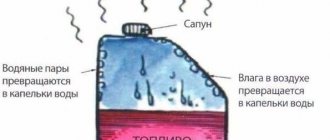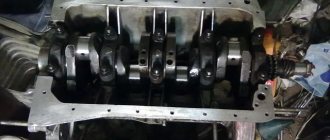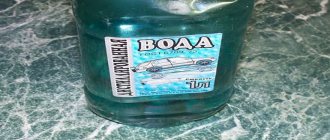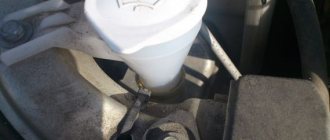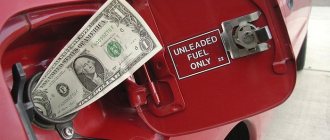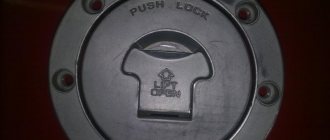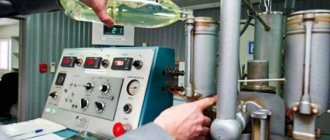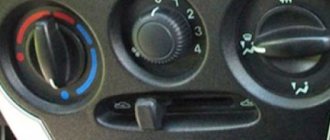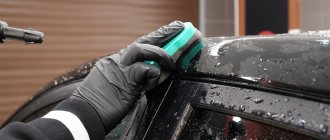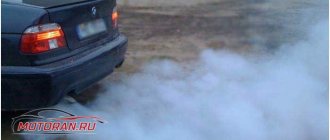Water may be present in each gas tank, the amount of it will depend on whether the tank is plastic or metal. There is more of it in a metal tank.
The appearance of water in a metal tank is a normal and common occurrence and occurs due to condensation of water and air on the walls of the gas tank. Condensation appears due to temperature changes and transitional weather conditions. Water can also get into the gas tank as a result of poor refueling. What is the danger of water and how to remove water from a car’s gas tank , what means there are for this, we will analyze in order in the article.
What do we have to do
If you have a gasoline engine and there is not a lot of water in the fuel tank, then take 0.2 to 0.5 liters of high-quality alcohol and pour them into the tank.
The following will happen:
- Water will mix with alcohol;
- The resulting mixture will acquire the same density as gasoline;
- Water will not freeze in pipelines;
- The mixture of water and alcohol will burn in the combustion chamber of the engine.
When preparing your car for winter, it is recommended to use this method to remove water from the fuel tank.
If your car runs on diesel fuel, then instead of alcohol, motor oil is poured into the fuel tank at the rate of 0.2 liters per 50 liters. DT.
What happens:
- Water and oil are mixed.
- A kind of emulsion is formed.
- An emulsion of water and oil burns in the combustion chamber of the engine.
How does moisture get into the gas tank?
Most often, the situation with the accumulation of gasoline and water in the fuel tank occurs in the off-season and in the cold season. The fuel that returns to the tank from the system has time to heat up and gradually warms up the remaining fuel. The moisture that is in the atmospheric air (it enters through the neck cover) comes into contact with the elevated temperature and condenses on the walls. Due to the difference in density of the two fluids, excess accumulates at the bottom and can enter the fuel system.
Water entering the fuel supply system threatens, first of all, with damage to electronic dosing systems - sensors, as well as injectors. Therefore, it is important to promptly detect the presence of water in the tank, as well as remove it from there. To do this, you will have to separate water and gasoline.
Alternative Methods
It would be wrong to think that auto chemical goods do not work in this direction and do not offer products on the market for removing water from the fuel tank. There are many such products and they are called dehydrators.
Unlike the methods described above for removing water from a gas tank, these products also provide other ranges of actions.
Thanks to the presence of anti-corrosion additives, dehydrators prevent the appearance of corrosion on the inner surface of all parts, components and assemblies of the fuel system.
Such auto chemicals, of course, are presented in a wide range on the car market and you need to be able to understand them.
There are disposable and multi-use dehydrators for both diesel and gasoline engines. You need to know this. Accordingly, the price is also different.
Good to know: Is it possible to mix water and antifreeze and pour it into the car?
How to remove water from a car's gas tank?
So, having understood in all details that water has no place in the engine, it’s time to think about how to deal with it. In fact, it's not difficult at all. And you don’t have to go to a car service center for this either. It is worth keeping in mind that water does not mix with gasoline at all. They remain separate factions; in a calm state, the water will be at the bottom and the fuel at the top. But water dissolves in any type of alcohol. They mix into a homogeneous liquid.
Armed with this knowledge, you can act in several ways:
Complain
How to prevent water from getting into the gas tank
- Fill up only at well-known gas stations that value their reputation;
- Avoid refueling at small private gas stations where the fuel is of questionable quality;
- In winter, try to keep the gas tank full. If the gas tank is not full in winter, condensation forms on its walls, which enters the fuel in the form of water.
- Change fuel filters on time;
- Do not trust those sellers who guarantee that the fuel is completely free of water. Even the highest quality fuel always contains some percentage of water. Accordingly, avoid such refills.
Using these recommendations and tips, you are guaranteed to remove water from the gas tank and subsequently reduce its entry again.
How does water end up in a fuel tank?
Before we talk about what to do if water suddenly appears in the gas tank, you should understand the reasons for its appearance there.
Many people can probably guess where the water in the gas tank could come from. But guesswork is clearly not enough here. It is necessary to accurately determine the cause. This will help prevent similar situations in the future and reduce all risks to a minimum.
It is believed that there are 2 main reasons for water ingress. But you can add two more to them. It is less common, but still exists.
- Condensation. Condensation forms as a result of a sudden change in temperature. The released moisture ends up in gasoline or diesel fuel. Most often this happens in winter. After driving around the cold city, the car drives into a warm garage, where the temperature is clearly above 0 degrees Celsius. As a result, small drops of moisture begin to appear on the inner walls of the fuel tank. They condense and begin to gradually drain, mixing with the fuel. Moreover, cars with a metal fuel tank rather than a plastic one are more susceptible to condensation. This is due to the properties of the metal to take temperature faster. That is, metal has greater thermal conductivity compared to plastic.
- Low quality fuel. A typical problem for many Russian gas stations. To increase profits, unscrupulous gas stations dilute fuel with water. Low-quality fuel also contains large fractions, some of which are moisture. The result of such refills is quite obvious. The tank is filled with an impressive amount of water. Hence all the ensuing consequences.
- Snow and rain. Not the most common situation. But it can happen. When refueling during rain or snow, if the gas tank cap is open, a small amount of moisture may enter. Sometimes even this amount is enough to cause problems.
- Moisture from the filling nozzle. It may be wet from washing, or as a result of condensation. The volumes of water are small, but they still exist.
Next, we’ll find out what water in gasoline can lead to, as well as what to do in such a situation.
How can moisture harm the fuel system?
Water entering the lines leads to corrosion of steel elements and disruption of the relative position of parts in the injection system. Frozen water in the lines leads to rupture of the outer wall or damage to the sealing rings. Negative consequences include fuel leaking through damaged lines, which leads to a fire.
Solidification of the fuel-water mixture has equally negative effects on spark-ignition engines and compression-ignition engines.
Ethanol
Water does not dissolve in gasoline, so it settles at the bottom of the tank. But it mixes very well with alcohol. This is its property and is used by drivers. Moreover, theoretically, almost any alcohol, including methyl alcohol, will do. However, ethanol or isopropanol is most often used in practice. The main thing is that it is not diluted.
When alcohol is added to the gas tank, it combines with water. The result is a substance with a density close to the density of fuel. As a result, water molecules rise upward, enter the fuel line and are gradually consumed in the engine along with the fuel. In addition, the resulting mixture stops freezing when the temperature drops, which is also important.
When exactly to add alcohol and in what quantities? Experienced motorists recommend adding it to the fuel immediately before refueling. You should open the filler cap, pour 500 ml of alcohol into it, and then refuel the car as usual. This amount is calculated for a full tank of gasoline. If you plan to fill it halfway, cut the alcohol portion in half.
If you choose methanol to remove water, be sure to handle it with care. Remember that its fumes are dangerous. Therefore, only work with it outdoors or in a well-ventilated area. And do not allow it to come into contact with mucous membranes.
Image source: drive2.ru
How to remove condensation from a gas tank using traditional methods?
Good afternoon. Today I will talk about how to remove condensation from a gas tank, when is the best time to do it and why remove condensation at all.
Where does water get into the gas tank?
As you know, 2/3 of the Earth's surface is covered with water, humans mostly consist of water, and even the atmospheric air, depending on the conditions, contains a lot of water vapor. Accordingly, there are a great many options for getting into the gas tank near the water:
— with each refueling, when you open the neck, air with water vapor enters the tank.
— sometimes we fill up on rainy days, and water gets into the tank in the form of precipitation.
— containers at gas stations also collect water, and pumps pump it along with gasoline.
Why remove condensate?
If you have previously read our materials, you probably did not miss the article about clogged fuel filters. The structure of the filter itself is made so that water passes through as poorly as possible. Often water is retained even by the coarse filter mesh (if there is not a lot of water).
In winter, water has an unpleasant feature - it freezes. Frozen water, near the intake grid or in the filter, significantly impedes the passage of gasoline and, as a result, the car stops working normally (starting is difficult, failures in operation, jerking, loss of power).
And all this happens because of harmless water.
How to remove condensation?
To get started, you can watch this video, but it is ruined by the advertising at the end:
Add alcohol to the tank.
It's no secret that various alcohols mix well with water and reduce its freezing point. Moreover, the most “advanced” citizens know that this produces vodka (in the case of ethyl alcohol), and everyone knows that vodka burns!
Accordingly, the simplest and most harmless option for removing condensation from the tank is to add alcohol. As practice has shown, 100-200 grams once a year is quite enough. Personally, I add alcohol in the fall, before the rains start.
It doesn’t matter what type of alcohol you use, as the result will be the same, but methyl alcohol is dangerous to health, and it is quite difficult to buy it. Since 2010, ethyl alcohol, previously freely sold in pharmacies, has been prohibited for sale without prescriptions, and you can buy it either in stalls or buy it from medical stores. workers. Well, the simplest, but most expensive option (about 100 rubles) is to buy isopropyl alcohol in stores for radio amateurs.
Alcohol is completely safe for fuel equipment and the engine; moreover, by adding alcohol you will feel an increase in power, as it increases the octane number of gasoline.
Add acetone to the tank.
The effect of adding acetone is similar to the effect of adding alcohol. Likewise, the octane number increases, but acetone has a disadvantage. It is more aggressive towards rubber hoses and O-rings, and while alcohol is guaranteed not to ruin anything, you use acetone at your own peril and risk.
What’s interesting is that on foreign cars you can safely pour 200-300 ml of acetone into the tank. for 40 liters of gasoline, and it will remove all moisture and will not damage the hoses. But in the case of cheap cars made in the Russian Federation, I would be afraid that in the end you can change all the fuel hoses, as they will simply corrode.
We use special liquids to remove water from the tank.
Praise be to marketers! The aspirations and suffering of drivers did not go unheard, and manufacturers began to produce special chemicals to remove condensate from the tank! Such products cost 150-400 rubles, depending on the brand and manufacturer, and are the same mixtures of alcohols and acetones, but in beautiful packaging and 4 times more expensive!
It’s up to you to use them or not, but as advertising taught us - “If you can’t see the difference, why pay more?”
Drain the condensate.
This advice will be useful to everyone who doesn’t like chemistry, doesn’t trust newfangled things and is used to solving a problem radically for 2-3 years.
The condensate can be drained!
If the car is quite old, it has a drain plug in the tank.
The algorithm of actions is as follows - pump out the gasoline to the maximum, unscrew the drain plug and leave the tank for several hours. This will drain everything from the tank, including debris and water and fuel sludge.
But on relatively new cars, there are no drain plugs, so the tank will have to be removed and installed in a position in which it will completely drain.
Conclusion.
As you can see, removing condensate from the tank is not difficult and useful. This should be done on most cars at least once a year. The only exceptions are some cars that have a lower fuel intake from the tank, for example the rare 123 Mercedes, where the tank is designed so that it does not physically accumulate condensate:
That's all for me today. I hope that the article about how to remove condensation from a gas tank completely answered this question. If you want to supplement it or have any questions, write comments.
Best regards, administrator
Share
Causes and symptoms of water in the fuel tank
Typically, water enters the gas tank through the hatch and neck before refueling. A hissing sound when the plug is unscrewed indicates the presence of air in the tank, the amount of which depends on the fuel level. The air contains moisture vapor, which accumulates in condensed form on the walls of the tank, and later turns into droplets at its bottom.
The appearance of water in the gas tank can cause failure of the fuel pump and other components of the car.
Condensation accumulates for quite a long time (several years may pass), but significant damage to the car, especially in cold weather, can be caused.
In addition, water in the tank may appear as a result of:
- adding water to fuel at a gas station;
- violations of fuel transportation and storage technology;
- intentional addition of water by third parties.
And finally, water can get in along with air if the seal of the gas tank is broken.
A leaky gas tank can also cause water to appear in it.
You can detect water in a gas tank quite simply by a number of indirect signs.
- After parking, the car does not start or starts with difficulty. However, the battery works fine. Often the fuel pump is located at the bottom of the tank, where water accumulates. When you try to start, condensate begins to flow into the engine instead of fuel.
- The engine "troits". In this case, the speed is set correctly, the cylinders and spark plugs are in perfect order. Most likely, the gasoline was diluted with water.
- There is a knocking sound in the engine. This is crankshaft vibration. It appears when starting a cold engine with the fuel tank half full. The knocking noise disappears after a while, as moisture evaporates as the engine temperature rises.
If there is water in the gas tank, strong crankshaft vibrations may be felt.
Water that gets into the engine from the gas tank can cause corrosion. Moreover, turning water into ice can cause the motor to freeze.
Humid atmosphere
The reason for the formation of water in the tank can be simple air humidity. This often happens in the spring (or autumn). Therefore, when you open the lid of a gasoline tank at this time of year, you can sometimes observe an accumulation of water on the lid. This is condensation. Condensation in the tank increases in direct proportion to air humidity. Droplets of moisture, together with gasoline, penetrate into the tank, and then precipitate at the bottom, because gasoline is lighter than water. Over time, moisture accumulates and the gas tank is gradually replenished with water.
Illiterate transportation or non-compliance with fuel storage conditions
It also causes the formation of water. And here, as in the first case, the person is often to blame. Gas station owners often neglect fuel storage rules, hoping that nothing bad will happen anyway. This is a manifestation of negligence towards your client.
Fog
It also poses a certain danger and forms water in the tank. High air humidity causes water seepage. Therefore, if there is a need to refuel at high air humidity, you should try to fill the tank full.
Human factor
Probably the rarest of all these reasons, but nevertheless it occurs. Your neighbors could be pests. The nature of human conflicts is very diverse: I installed the car wrong, looked at it wrong, bought a car that is not like everyone else’s (expensive, beautiful, dynamic, and so on). Often, banal envy pushes people to do not the most beautiful things. So they can add some water to the tank, so that later in the morning from the window, while drinking a cup of coffee, they can contemplate the pleasant sight of a neighbor running around his car, swearing loudly and cursing everything around him.
Comparison of moisture removers
No matter how good alcohol is at its job, I would like to pay more attention to modern means designed specifically for removing water from a car’s fuel system, of which there are more and more on the market lately.
Reputable publications conducted tests of such special tools, as a result of which it was possible to compile a certain rating. They took an ordinary transparent glass and poured 500 ml of gasoline and 10 ml of water into it. Then, moisture-removing additives were added little by little.
STP
During the tests, the dehumidifier and fuel system cleaner STP, produced in the UK, took fifth place. The volume of the bottle is 946 ml, which, according to the manufacturer, is enough for 40–80 liters of fuel. In terms of price, this product turned out to be the most expensive among the rest of the test participants. Probably, foreign origin had an effect. It contains no alcohol, but the mechanism of operation is not explained by the manufacturer. As a result of the tests, the volume of STP water removed was only 15–20 ml, which is the lowest value in the test.
The only advantage is the absence of alcohol in the composition, which protects the engine in the event of an overdose of moisture remover.
Well, the disadvantages are, first of all, low efficiency and high cost.
3TON
The fourth place was taken by the domestic dehumidifier and cleaner 3TON, produced by Dolphin-Chemicals LLC. The bottle volume is 354 ml and should be enough for 45–80 liters of fuel. Like the previous sample, this product is a kind of universal option that can both remove moisture and clean the system. But with its main purpose - cleaning the gas tank from water - it copes worse than specialized additives. The bottle is capable of lifting only 23–26 ml of water; the raised liquid is well retained in the thickness of gasoline. The price is almost half that of the previous test subject.
The advantage is the versatility of the additive, its low price and ability to retain water in the fuel column.
Minus for poor moisture removal.
RunWay
In third place is another Russian water remover from the fuel system called RunWay, produced by Aviastroy-SPb CJSC. The liquid in the bottle takes up 300 ml and should work fully in 50–60 liters of gasoline. Like previous preparations, it can remove moisture, clean fuel system parts and prevent corrosion. Once again we are convinced that a universal tool cannot cope equally well with each of the tasks. He failed to succeed in removing moisture. Lifts 28–32 mg of water per whole bottle. It holds it in the thickness of gasoline quite poorly. But the price is even less than the sample in fourth place.
Pros: low price.
Disadvantages: low efficiency of water removal, does not retain it well in the fuel.
Expert
Second place goes to the Russian-made Expert dehumidifier for gasoline engines from Rusholts LLC. The volume of the substance in a 250 ml bottle is capable of operating with 40–60 liters of gasoline. It has good water removal performance, but does not retain it well in the fuel layer. This additive can give a good effect only if the car is in motion and the gasoline in the tank is constantly mixed. The bottle is capable of lifting 40–45 ml of water. The Expert preparation specializes only in removing moisture and copes with its task as it should. The price for it is also pleasing and only emphasizes its advantages.
Pros: removes moisture efficiently, low cost.
Cons: does not retain water well in the fuel volume.
BBF
Well, the leader in the tests was again the Russian BBF moisture remover produced by Khimpromproekt CJSC. The container contains 325 ml of active substance, which copes with 40–60 liters of fuel. The additive specializes only in removing moisture and does an excellent job. It retains water well in the volume of fuel. The cost is slightly higher than previous domestic analogues, but the efficiency is much higher.
Pros: perfectly raises moisture and keeps it in the thickness of gasoline, low price.
The only disadvantage can be called the narrow specialization of the additive, but even that is a stretch, because the purpose of the tests was only to find the best dehumidifier.
Summarizing a certain result after comparing these moisture removers, we can conclude that expensive foreign preparations are not always better at removing water from the tank. Versatility also has a bad effect on each property of the additive.
